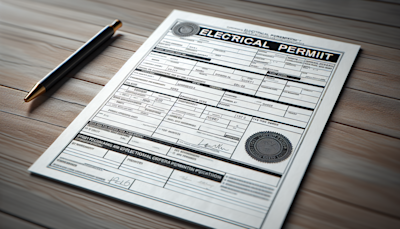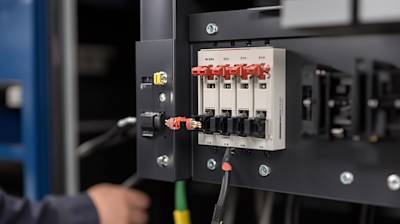Understanding the ins and outs of an electrical rough in is crucial for anyone involved in house construction or renovation. This phase of the project ensures the future safety and efficiency of your home's electrical system. Here, we will delve deep into the specifics of an electrical rough in, including what it entails, why it’s an important process in home building and renovation, and how to navigate through it. We will work towards improving your appreciation for this underappreciated but key aspect of your home's construction or renovation.
The Basics of Electrical Rough In
The electrical rough in refers to the phase in home construction where the electrical wiring, outlets, switches and other components are installed, but not yet connected to the main panel. During the rough in, electricians lay the foundation for the network of wiring that will ultimately power your home. The process involves a series of intricate steps that require thorough planning and precision.
Stages of an Electrical Rough-In
A well-executed electrical rough-in is crucial for ensuring that your building's electrical system is safe, efficient, and compliant with local codes. As a professional electrician, I break down the process into the following key stages:
Drawing Up and Following a Detailed Electrical Plan
Everything starts with a detailed plan. This blueprint outlines where all electrical panels, outlets, switches, and fixtures will go. It’s crucial to follow this plan closely to ensure compliance with building codes and safety standards.
Installation of Electrical Boxes
Once the plan is in place, the next step is to install electrical boxes at the designated points. These boxes are the mounting points for switches, outlets, and other fixtures. Proper placement and installation are key to a functional electrical system.
Running Wires
After the boxes are installed, the next phase is to run wires from these boxes back to your main service panel. This includes running wires between boxes to ensure that all components are connected as per the electrical plan. This step is critical for establishing the pathway for electrical currents.
Labeling Wires
Labeling each wire might seem like a small step, but it’s essential for future maintenance and troubleshooting. Labels should indicate the wire’s purpose and destination, making it easier for anyone to understand the system later.
Securing Wires
Securing the wires ensures they stay in place and are protected from damage. This involves stapling or clamping the wires neatly along their running paths. Proper securing also reduces the risk of electrical fires and faults.
Preparing for Inspection
Before closing up walls, an inspection must be done. This step involves comparing the installed system with the electrical plan to ensure everything matches and is up to code. The inspection is crucial for catching any potential issues that could affect safety or functionality.
The Importance of Electrical Rough-In
An electrical rough-in might appear as just another phase in the building process, but it is indeed a cornerstone of construction safety and functionality. Here are the key reasons why a meticulous approach to electrical rough-in is absolutely crucial:
Foundation for All Electrical Connections
The electrical rough-in lays the foundational wiring and connections that will power the entire building. It involves the placement of wires, electrical boxes, and service panels that will later be connected to the main power supply. Mistakes made during this stage can lead to serious issues, affecting everything from the usability of outlets to the functionality of electrical appliances. Ensuring accuracy here is critical because errors are often difficult and expensive to correct after walls and ceilings are sealed.
Impact on Home Value
The quality of electrical work in a home significantly influences its overall value. Prospective homebuyers or inspectors look for a safe, well-executed electrical system compliant with building codes. A well-done electrical rough-in not only boosts confidence in the safety and functionality of the home but also enhances its market value by meeting these expectations.
Prevention of Electrical Accidents
Properly executed rough-ins reduce the risk of electrical accidents. This includes preventing short circuits, which can lead to fires, and ensuring that all connections are secure to avoid potential electric shocks. Furthermore, a correctly installed electrical system protects appliances from damage caused by inconsistent power supply or surges. The grounding and circuit protection implemented during the rough-in are vital for the safe operation of all electrical devices in the home.
Ensures Compliance with Safety Codes
Electrical rough-ins must adhere to strict safety codes and standards. These regulations are designed to ensure that every aspect of the electrical system is safe and capable of handling the expected electrical load. Compliance not only avoids legal and regulatory issues but also ensures that the electrical system is safe for all occupants.
Facilitates Future Upgrades
A well-planned and executed electrical rough-in makes future upgrades or modifications easier and safer. It allows for easier access to wiring and a clearer understanding of the circuit layout, which is invaluable during renovations or when adding new appliances.
Tips for Effective Electrical Rough In
Planning and executing an electrical rough in is a task best left to professionals. However, if you’re committed to doing it yourself, consider the following tips:
-
Maintain a Detailed Plan: Always start with a comprehensive and detailed plan of your envisioned electrical setup. This plan should include the location of outlets, switches, light fixtures, and the route of all wiring.
-
Gather Necessary Tools and Materials: Before beginning, ensure you have all the essential tools and materials needed for the installation. This includes wires, conduits, electrical boxes, switches, and proper safety gear.
-
Double-Check Your Work: After installation, go over your work to confirm that all wires are installed correctly and safely. Verify that everything aligns with your initial plan and adheres to local electrical codes.
-
Avoid Rushing: Take your time with the installation. Rushing can lead to mistakes that may have dangerous consequences. Quality and safety should always take precedence over speed.
-
Consult a Professional: If you encounter any uncertainties or complex situations, don't hesitate to consult a professional electrician. It’s better to seek professional advice than to risk making costly or hazardous errors.
Electrical rough in is crucial when it comes to the safety and efficiency of any home. It requires detailed planning, preparation, and in many cases, professional execution. With careful attention to detail and respect for the process's importance, a well-done electrical rough in provides a robust and reliable electrical system to power our homes safely and efficiently.
Frequently Asked Questions About Electrical Rough-In
What is the purpose of electrical rough-in?
Rough-in electrical wiring is considered a critical part of the building and remodeling process as it provides the framework for the final installation of outlets, switches, and lighting fixtures. It involves laying the groundwork for your house's electrical system, which includes running wires through the walls and ceilings and setting up boxes for power outlets and light switches.
When does the electrical rough-in process take place?
The electrical rough-in process typically happens once the framing of a house or a room has been completed, but before the drywall or other wall coverings have been installed. This allows for easier installation and adjustments of wiring and fixtures as well as inspection.
Who should perform electrical rough-in?
In the majority of cases, a licensed electrician should handle the electrical rough-in work. It's important due to safety reasons and overall accuracy of the project, as incorrect wiring could potentially lead to fire hazards or other risks.
What is involved in an electrical rough-in inspection?
An electrical rough-in inspection ensures that all electrical wires, boxes, and fixtures are safely and correctly installed according to local building codes. Inspectors will look at the type and size of wires used, verify proper grounding, and ensure that the circuits are correctly organized and labeled in the breaker box.
How long does the whole electrical rough-in process take?
The duration of the electrical rough-in process largely depends on the size and complexity of the project. For a new build home, the process may take several days to a week, but for a small renovation project, it may only take a day or two.
Is there a specific electric rough-in code to follow?
Yes, every locality has specific electrical codes that need to be adhered to during the rough-in process. That's why it's important to hire an experienced, licensed electrician who has in-depth understanding of these norms and is adept at accomplishing the process accordingly.
What materials are typically used in electrical rough-in?
Standard electrical rough-in materials include various sizes of electrical wires to carry different loads, electrical boxes to house outlets and light switches, conduit to protect wiring, and staples to secure wires within wall and ceiling cavities.
How can I prepare for my electrical rough-in?
To prepare for an electrical rough-in, you should have a clear idea of your electrical needs including the placement of lighting fixtures and number and type of outlets required. Also, hiring a licensed electrician is crucial to the success of any electrical project, as they can provide expertise, follow safety protocols, and abide by local electrical codes during work.
Is there anything to be cautious of during an electrical rough-in?
Yes, there are safety considerations to be aware of. Wiring systems are to be designed and installed to avoid overheating or fire hazards. It is crucial to avoid damaging electrical wires during the installation process. Amateur installation can lead to code violations and safety risks, emphasizing the need for a licensed professional.
Are permits necessary for an electrical rough-in?
Many areas do require permits for electrical installation, including for the rough-in stage. To confirm, it's best to check with your local building department or hired electrician, who can help facilitate necessary permits before starting the project.
PROS AND CONS OF ELECTRICAL ROUGH IN
PROS
1) Lower Construction Costs
Electrical rough ins, done during the initial stages of construction, can significantly reduce overall costs. Since the necessary wiring is integrated into the initial build, it avoids the need for costly rebuilds or adjustments later.
-
Electrical devices can be tested earlier, which helps in catching any mishaps or mistakes before the rest of the wiring gets laid out.
-
There are fewer chances of reworks and superficial damages on the walls and other structures as the electrical rough in happens before the installation of wall or ceiling surfaces.
2) Enhance Design Implementation
The electrical rough in where the appropriate wiring and devices are put can help effectively implement the architect's design. If not planned properly, electrical elements can obstruct design aesthetic.
-
Flexibility for designing electrical components as per space.
-
Helps maintaining the esthetic of the room without affecting the functional aspects.
3) Navigation Translation
Electrical rough ins help in establishing a map or guideline for where the finished electrical components will be placed. It makes the work easier for other tradesmen who will be working on the project later.
-
Easier and safer navigation around the construction site.
-
Less potential for conflict among multiple contractors and tradesmen.
CONS
1) Degree of Complexity
The degree of complexity in the electrical rough in process can be a major issue. If not done correctly, it can lead to failure in the electrical system of the house or building.
-
Requires skilled and professional electricians with a good understanding of the construction plan.
-
Slight errors can lead to significant problems in the long run.
2) Risk of Short Circuiting
The risk of short circuiting increases during electrical rough in because of the increased likelihood of wires crossing. If the electricians are not cautious enough, it can cause a dangerous situation.
-
Poor wiring can lead to circuit overloads and fire hazards.
-
Unexpected property damages and can even risk human life.
3) Time-Consuming
Electrical rough ins can be a time-consuming process because of the meticulous details required. Every electrical box location, light switch, power outlet, etc., needs to be considered and correctly placed.
-
Additional time investment can delay other construction processes.
-
Many electrical requirements may need to be finalized before the initiation of the project, which may be impractical for homeowners who want a flexible design process.
Summary
Completing the electrical rough in is a critical step when putting up a new building or doing an extensive renovation. This process involves installing all the electrical wires, boxes, and breaker panels. By having the electrical rough in done properly, you're ensuring the safety and sufficiency of the electrical system in the building.
Not every handyman can carry out an electrical rough in accurately. It requires advanced knowledge of electrical systems, local codes and precise attention to detail. Hiring a licensed electrician to handle this task can save you from unnecessary costs and potential risks down the line.
To wrap up, the electrical rough in stage is perhaps one of the most significant phases in any construction project. Its completion ensures that your home or office is ready for the final construction touches like drywall and paint. So, never underestimate the importance of getting the electrical rough in done right.
About Sagan Electric
Welcome to Sagan Electric, your reliable and trusted electric service provider in Sacramento, CA. We're specialized in residential and commercial electrical systems, bringing to the table our unmatched passion for quality work and customer satisfaction. For years, we've built a reputation of excellence, thanks to our team of professional electricians who are driven by the desire to meet and exceed client expectations. So, whether you're thinking about a small electrical project or large scale electrical setup, remember Sagan Electric got you covered!
Tags: electrical wiring, home renovation, electrician tips,








